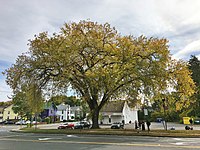
Photo from wikipedia
Simple Summary Elm (Ulmus pumila) is a strong essential wood, and it is widely used in cabinets, sculptures, and ship making. In the present study, phenotypic and comparative transcriptomic analyses… Click to show full abstract
Simple Summary Elm (Ulmus pumila) is a strong essential wood, and it is widely used in cabinets, sculptures, and ship making. In the present study, phenotypic and comparative transcriptomic analyses were performed in elm fast- (UGu17 and UZuantian) and slow-growing cultivars (U81-07 and U82-39). Phenotypic observation showed that the thickness of secondary xylem of 2-year-old fast-growing branches was greater compared with slow-growing cultivars. Comparative transcriptome analysis predicted that many pathways were involved in vascular development and transcriptional regulation in elm, such as “plant-type secondary cell wall biogenesis”, “cell wall thickening”, and “phenylpropanoid biosynthesis”. NAC domain transcriptional factors (TFs) and their master regulators, cellulose synthase catalytic subunits (CESAs), xylan synthesis, and secondary wall thickness were presumed to function in the thickening mechanism of elm branches. Our results indicated that the general phenylpropanoid pathway and lignin metabolism had vital functions in the growth of elm branches. Abstract Wood plays a vital role in human life. It is important to study the thickening mechanism of tree branches and explore the mechanism of wood formation. Elm (Ulmus pumila) is a strong essential wood, and it is widely used in cabinets, sculptures, and ship making. In the present study, phenotypic and comparative transcriptomic analyses were performed in U. pumila fast- (UGu17 and UZuantian) and slow-growing cultivars (U81-07 and U82-39). Phenotypic observation showed that the thickness of secondary xylem of 2-year-old fast-growing branches was greater compared with slow-growing cultivars. A total of 9367 (up = 4363, down = 5004), 7159 (3413/3746), 7436 (3566/3870), and 5707 (2719/2988) differentially expressed genes (DEGs) were identified between fast- and slow-growing cultivars. Moreover, GO and KEGG enrichment analyses predicted that many pathways were involved in vascular development and transcriptional regulation in elm, such as “plant-type secondary cell wall biogenesis”, “cell wall thickening”, and “phenylpropanoid biosynthesis”. NAC domain transcriptional factors (TFs) and their master regulators (VND1/MYB26), cellulose synthase catalytic subunits (CESAs) (such as IRX5/IRX3/IRX1), xylan synthesis, and secondary wall thickness (such as IRX9/IRX10/IRX8) were supposed to function in the thickening mechanism of elm branches. Our results indicated that the general phenylpropanoid pathway (such as PAL/C4H/4CL) and lignin metabolism (such as HCL/CSE/CCoAOMT/CCR/F5H) had vital functions in the growth of elm branches. Our transcriptome data were consistent with molecular results for branch thickening in elm cultivars.
Journal Title: Biology
Year Published: 2022
Link to full text (if available)
Share on Social Media: Sign Up to like & get
recommendations!